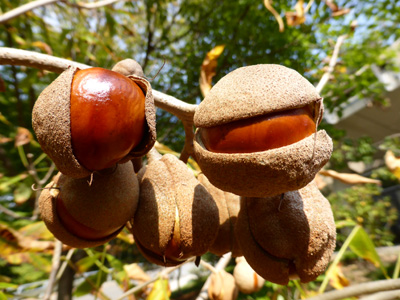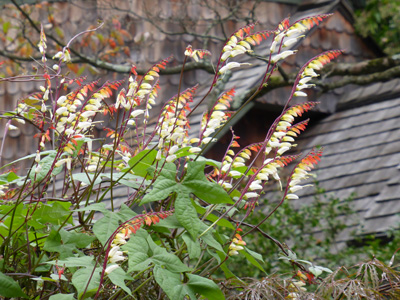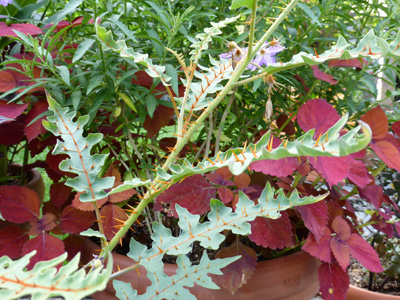Plants of the Week: October 14
 Acorns aren’t the only tree fruit dropping during the short days of October. The smooth, globular capsules of Aesculus pavia, the red buckeye, are splitting. One, sometimes several, shiny brown seed falls to the ground. Native to the southeastern United States, Aesculus pavia thrive in moist soils and benefit from some shade. Dry conditions lead to the development of leaf scorch and early leaf drop. A mature tree in full flower – panicles of vivid red flowers held above the foliage – is a sight to behold. Photo credit: J. Coceano
Acorns aren’t the only tree fruit dropping during the short days of October. The smooth, globular capsules of Aesculus pavia, the red buckeye, are splitting. One, sometimes several, shiny brown seed falls to the ground. Native to the southeastern United States, Aesculus pavia thrive in moist soils and benefit from some shade. Dry conditions lead to the development of leaf scorch and early leaf drop. A mature tree in full flower – panicles of vivid red flowers held above the foliage – is a sight to behold. Photo credit: J. Coceano
Garden Location: Adjacent to the Glade Garden
 Annual vines are an underrepresented group of plants in summer and early autumn gardens. A personal favorite is the firecracker vine, Ipomoea lobata (syn. Mina lobata). The twining vine is easily started in spring from seed and will quickly cover a shrub or structure. Full sun conditions result in earlier flowering compared to those planted in partial sun. Flower spikes, roughly five inches in length, bear flowers ranging in colors from red, scarlet, orange, yellow and cream. Late day sunshine sets the flowers aglow. Photo credit: J. Coceano
Annual vines are an underrepresented group of plants in summer and early autumn gardens. A personal favorite is the firecracker vine, Ipomoea lobata (syn. Mina lobata). The twining vine is easily started in spring from seed and will quickly cover a shrub or structure. Full sun conditions result in earlier flowering compared to those planted in partial sun. Flower spikes, roughly five inches in length, bear flowers ranging in colors from red, scarlet, orange, yellow and cream. Late day sunshine sets the flowers aglow. Photo credit: J. Coceano
Garden Locations: Several vines are planted around the Cunningham House
 Members of Solanaceae are agronomically important and sinister in nature. Peppers, tomatoes, and potatoes have shaped the diets of numerous cultures. Embedded within those very cultures are tales and practices using those crops’ deadly cousins. Datura, Brugmansia, and Atropa are but three genera containing potent and toxic alkaloids. Other members exhibit threatening morphology. Solanum pyracantha produces artistically cut leaves lined with bright orange spines. Both the upper and underside of the leaves, as well as the stem, are covered in the colorful spines. While dangerous up close, the plant is captivating. Site with caution! Photo credit: J. Coceano
Members of Solanaceae are agronomically important and sinister in nature. Peppers, tomatoes, and potatoes have shaped the diets of numerous cultures. Embedded within those very cultures are tales and practices using those crops’ deadly cousins. Datura, Brugmansia, and Atropa are but three genera containing potent and toxic alkaloids. Other members exhibit threatening morphology. Solanum pyracantha produces artistically cut leaves lined with bright orange spines. Both the upper and underside of the leaves, as well as the stem, are covered in the colorful spines. While dangerous up close, the plant is captivating. Site with caution! Photo credit: J. Coceano
Garden location: In container on the Cosby Courtyard near Kohlberg Hall





No Comments